Are you taking advantage of cardboard in your art classes? Cardboard is one of my secrets to art teaching success. In these times of diminishing art supply budgets and overwhelming class sizes, cardboard can become your best friend. Not only is cardboard abundant, it is resilient and versatile.
Here are my top 5 reasons cardboard can help art educators with their classes.
1. Cardboard Is Cheap or Free
All it takes to get free cardboard is a little extra effort when you are out and about. Cardboard is found just about everywhere, from restaurants to paint stores. Most establishments recycle their cardboard, and they are eager to give it away or donate it to your classroom. Pizza parlors will often donate a stack of fifty pizza boxes to my art program. Paint stores are constantly giving away their cardboard paint flats. Grocery stores have heaps of cardboard waiting to be crushed in the baler. All you need to do is to politely ask to take some cardboard off an establishment’s hands, and often you will receive a substantial amount.
If you are not lucky enough to acquire all the donated cardboard you need for a given project, it is relatively cheap to purchase. For example, a set of fifty flat pizza boxes can be as little as $20 (plus delivery). Cutting that amount of cardboard can easily provide enough material for an entire class project.

2. Cardboard Holds Supplies
Markers, colored pencils, paint tubes, water cans, and most art media can be stored in cardboard boxes. I use cardboard flats from paint stores as portable trays that hold paint tubes and palette knives for students to take to their tables. Those same flats are great for holding cans, markers, primer, and any other set of materials that needs to be organized. Cardboard flats allow smaller table groups to easily retrieve sets of materials instead of having a free-for-all storage area somewhere in your room.

3. Cardboard Makes a Great Painting Surface
The pizza box makes a wonderful painting surface. One full pizza box can be cut down into two to four pieces. Cardboard also stimulates student interests. For some reason, when I bring out stacks of sliced cardboard to distribute as the next project surface, students treat it more seriously than paper.
Cardboard usually absorbs paint pretty well, but it can have a tendency to curl at the corners. The curling effect happens from only painting on one side. The first step with students when painting on cardboard is to paint a giant “X” on the back side. I like to use primer for this activity, but any type of paint should work fine. Have students apply a generous amount of paint from corner to corner and allow it to dry. The next day, have students put primer on the front side of the box and it should flatten out and remain flat for the most part. If it curls after that, I have students repaint the back side of the cardboard and place a heavy object on top of it to weigh it down. Once that dries, it is usually quite flat.
4. Cardboard Makes Perfect Palettes
The palettes I use with students are simply rectangular pieces of cardboard. Students mix their paint colors on the cardboard and then scrape all the unused paint flat at the end of class. The paint dries and we reapply paint on top of the dry layer the next day. When using acrylic-based paint, this is an effective palette that can be used for years. The key to making this work is to make sure scraping the palette becomes an important procedure of cleanup time. The smoother the surface of the cardboard, the longer it remains effective as a palette.

5. Cardboard is a Perfect Sculpture Material
When my students are making three-dimensional art, often scraps of cardboard are essential to their work. I like to save all the leftover scraps of cardboard I have from cutting down surfaces for painting and encourage students to use those later on to form sculptures. Cardboard is malleable and easily glued or taped together. Students can use cardboard to help create the form underneath a mask, or as the structure for a sculptural artifact. Building forms from cardboard parts is easy for students and accessible for educators.
As art educators, we are always searching for ways to minimize our supply budgets. Cardboard can be completely free, or at least very cheap. I use cardboard for painting surfaces, palettes, sculptural building blocks, and to house classroom materials. The amount of money I save from buying plastics and papers is enough to put toward other essential materials. Cardboard is one of my secrets to art teaching success. I hope you take advantage of this resource too!
How do you use cardboard in your art classes?
What other secrets do you have for your own art teaching success?
Magazine articles and podcasts are opinions of professional education contributors and do not necessarily represent the position of the Art of Education University (AOEU) or its academic offerings. Contributors use terms in the way they are most often talked about in the scope of their educational experiences.





